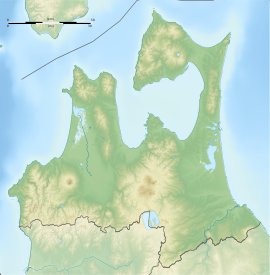Mount Osore
| Osore-zan Bodai-ji | |
|---|---|
恐山 菩提寺 | |
Jizō Bosatsu | |
| Location | |
| Location | 3-2 Tanabu Usoriyama, Mutsu-shi, Aomori-ken |
| Country | Japan |
| Geographic coordinates | 41°19′37.39″N 141°5′24.97″E / 41.3270528°N 141.0902694°E |
| Architecture | |
| Founder | Ennin |
| Date established | 862 |

Mount Osore (恐山, Osore-zan) is the name of a Buddhist temple and folk religion pilgrimage destination in the center of remote Shimokita Peninsula of Aomori Prefecture, in the northern Tōhoku region of northern Japan. The temple is located in the caldera of an active volcano and is believed in Japanese mythology to be one of the gates to the underworld.
Etymology
The mountain was once called Usoriyama by the Ainu people, but was gradually changed by the Japanese to Osore, meaning "dread", which may be a statement to the sites of enshrined dead in the area.[1]
Mount Osore volcano
The mountain is one peak of the Osore-zan Mountain Range (恐山山地, Osore-zan Sanchi), a series of eight
During the
Bodai-ji temple and pilgrimage location
The mountain is the location of a Sōtō Zen Buddhist temple, Bodai-ji (菩提寺), which claims to have been founded in 862 AD by the famed monk Ennin, with Jizō Bosatsu as its main image. The temple was abandoned in 1457 and restored back to use in 1530.[4] In popular folk religion, the otherworldly setting of Mount Osore, with its charred landscape of blasted rocks filled with bubbling pits noted for unearthly hues and noxious fumes came to be one of several places in Japan identified to be an entrance to the Underworld. A small brook running to the neighboring Lake Usori was equated to the Sanzu River, a river that deceased souls need to cross on their way to the afterlife.
A unique feature of Bodai-ji is the presence of mediums known as itako who claim to summon the souls of the dead and deliver messages in their voices. These mediums were traditionally blind and had to receive extensive spiritual training and purification rituals; however, in modern times, their number has dwindled and not all are blind. The temple has a twice-yearly Itako Taisai festival held in summer and autumn.
The temple also maintains a hot spring resort for use by pilgrims and tourists.
In modern culture
The work of contemporary artist
As part of a collection of fictional
Gallery
-
Sōmon gate of Bodai-ji
-
Sammon gate of Bodai-ji
-
Lake Usori
-
Effigy of a child
Notes
- ^ Chris Bamforth (22 December 2006). "Mountain of dread". The Japan Times. Retrieved 10 February 2020.
- ^ The Smithsonian Museum of Natural History states that an eruption occurred in 1787, but this is not corroborated by Japanese sources
- ^ "Osore Zan". Geological Survey of Japan. Retrieved 6 June 2020.
- ^ "About Mount Osore - Aomori Travel Guide | Planetyze". Planetyze. Retrieved 2017-11-08.
- ^ A picture of this piece while at the Marianne Boesky Gallery in March 2009 may be seen here.
- ^ "Takeshi Yamada, Art & Rogue Taxidermy, Center for Medical Mycology in Coney Island, Brooklyn, New York, Contact, [email protected] - TAKESHI YAMADA Art & Rogue Taxidermy". Archived from the original on 2015-06-26. Retrieved 2015-06-26.
References
- Fackler, M. (2009, August 20). As Japan's mediums die, ancient tradition fades. The New York Times, p. 8, Retrieved from https://www.nytimes.com
- Global Volcanism Program. (n.d.). Osore-yama. Retrieved from http://www.volcano.si.edu/world/volcano.cfm?vnum=0803-29=
- Ivy, M. (2010). The art of cute little things: Nara Yoshitomo's parapolitics. Mechademia, 5(1), 3-29. doi:10.1353/mec.2010.0020
- Wonderland Japan WAttention. (n.d.). Mt. Osore. Retrieved from https://www.webcitation.org/6Bp5xzjwO?url=http://www.wattention.com/archives/mt-osore
- Yamada, T. (2011, June). Skull mushroom. Retrieved from https://www.flickr.com/photos/museumofworldwonders2/5725108088






